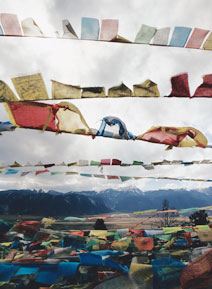I’d read about Shaxi’s Sideng hamlet, which contains the last intact market square along the 2,175-mile caravan trail. Recently named one of the world’s “100 Most Endangered -Monuments” by the World Monument Fund, it was partially restored several years ago but feels unchanged, just as the muleteers left it. The merchant inn, the temple, and the opera stage still face the square, empty now but for trees and cobbles and piles of drying corn. Outside the village gates, the caravan trail is still a dirt track that winds between trees and over small stone bridges as it vanishes into the distance.
In the shady courtyard of the Ouyang family’s two-story carved-wood house, we had a fascinating vegetarian lunch. The star dish was a stir-fry of Yunnan’s celebrated wild mushrooms—but the platter of bean jelly was what set my head spinning. Thick-sliced and chewy-firm, it was a jelled bean starch reminiscent of Japan’s konnyaku and Korea’s dotorimuk. The Ouyangs topped it with an addictive chile-and-Sichuan-peppercorn sauce flecked with cilantro and crumbled peanuts. It was delicious, satisfying, and all but calorie-free.
I soon learned that bean jelly, now popping up on menus in Beijing and Shanghai, is a long-standing Yunnan favorite and a culinary signature of the caravan trail. Each trade center has not only its traditional toppings but its own local bean. In Dali it’s the wan dou, whose buttercup-colored jelly is often sliced into noodle shapes and called yellow bean noodle; in Lijiang, it’s the ji dou, which yields a jelly of gray green.
Through the centuries, when northbound caravans left Sideng hamlet by the trail, they traveled through mountain valleys and rhododendron forests to Lijiang. Now the journey is easy—I went by bus—and this ancient capital of the Naxi people has morphed into another magnet for visitors.
The Naxi have been in the Lijiang Valley for 1,400 years. They remain semimatriarchal, and in villages near Lijiang such as Baisha and Yuhu, their traditional lives can still be glimpsed, as women rake grain and men carry small children. In Yuhu, visitors can tour the home of Joseph Rock, the Austro-American botanist who gathered plant specimens, pioneered study of the pictographic Dongba language, and sent back thrilling reports via National Geographic. In one 1925 article he wrote, “I took with me my Siamese boy, the Tibetan cook and two Naxi servants.” And that was in addition to a gramophone, a collapsible bathtub, and ten Naxi soldiers, who sat around a fire at night firing off shots “to let marauders know that we meant business in case of attack.”

Nowadays popular excursions from Lijiang include cycle tours, ecotours, and my own favorite, the overnight trip to Lugu Lake, where the Mosuo people live in what some claim is the world’s last true matriarchy. Mosuo women never marry, but take such lovers as they please throughout their lives. They call their system zou hun, or walking marriage. At 13, each girl gets her own room with a box bed, a hearth, and a window to be opened for the man of her choice. Life at the lake today appears little changed from Joseph Rock’s 1920s photographs, on display in the main village. Yet as I watched dancers circle a bonfire to the music of a single wooden flute, I couldn’t help but think of something a man in Kunming had told me of this remote place: “In ten years, they will build a good road to Lugu Lake, and then that too will be gone.”
Even with options like these, most tourists stay in Lijiang’s Old Town. This district of cobbled streets with no cars and gorgeous Naxi architecture was restored after a 1996 earthquake with charm in mind. It’s crowded. It’s a bit ersatz. Yet the lovely buildings, gurgling streams, and majestic clouds scudding across the face of Jade Dragon Mountain more than compensate. And I liked seeing Naxi people in their own dress step through a circle dance, or set up a row of chairs to play traditional music—even if, as one Chinese man joked, they go home after eight hours and put their regular clothes back on.
Then there was the bean jelly. The vast vegetable market outside the Old Town was the place to eat it street-style, choosing from a mouth-tickling array of sauces and toppings. Every restaurant had it, and some places, like Haku Café, served it both cold and hot fried. I returned to this little place over and over, drawn by the good food and free Internet access, and by the home-away-from-home atmosphere. So delightful was the second-floor dining room, with its windows flung wide to the traditional rooftops, that I saw diners stay and play cards all evening, ordering coffees or drinks from the bar downstairs.
If Haku Café was the place to relax, Mishixiang Restaurant scored for group dining. After training in Guangzhou, chef Cun Yongheng returned with a full menu of excellent Naxi, Can-tonese, and Western dishes. He was one of several chefs to stress the Cantonese connection. Cantonese methods started to infiltrate local cuisine during the Second World War, when Yunnan became important to the Guomindang army as the Chinese terminus of the Burma Road. Chefs have always accompanied Chinese armies. By mid-century, Chiang Kai-shek was gone, but Cantonese techniques tending toward lightness, like steaming, stayed on.
In Lijiang I could also taste traces of the Tibetans, the next great ethnic group along the trail. Stalls sold dried yak meat, and vendors offered luscious yak skewers dusted with chile powder and cooked over charcoal. Once again cuisine was traveling the trail, announcing the world that lay ahead.


 Pinterest
Pinterest






